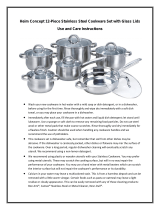• Take care when placing pans on gas hobs as the number of support legs vary and small pans in particular may need a trivet, which most gas hob manufacturers will supply with their
hob or can be bought from them separately.
• On a ceramic hob, take care that your hob and the base of the pan/ pot are perfectly clean to avoid anything getting trapped between than pan and the hob, thereby scratching the
hob.
• Never drag pans across the surface – always lift the pan/pot off.
• Never “agitate” frypans, woks or sauté pans on the hob whilst cooking. To move the food in the pan, use a suitable utensil.
Use on an induction hob
Induction is a heating method, which is much faster and more powerful than other heat sources. To guarantee the performance of your cookware:
• Never heat pots and pans when empty
• When preheating your pan, we recommend that you set the hob (output level) to a mid-range temperature setting (you should consult the operating instructions for your induction
hob).
• If using a non-stick coated pan use the thermospot technology so that you can see when the pan has reached the perfect cooking temperature, then add your food and reduce the
heat to maintain the temperature (to prevent overheating the pan).
Note: The efficiency of the pan may be affected by the diameter and power of your hob.
Helpful hints on lid use
• Always use oven gloves when removing a lid during cooking, tilt it to direct steam away from you and keep hands and face away from vents.
• Do not use glass lids that have cracks, chips or scratches and do not attempt to make repairs to damaged cookware. Avoid the use of damaged cookware lids. For safety reasons if
the glass shatters it is designed to break up into small pieces and shatter downwards rather than outwards.
• Do not place hot glass lids into or under cold water or directly onto a cold work surface as an extreme temperature change can break the glass. This is not covered under the
guarantee.
• Tempered glass lids are oven safe up to a maximum or 350°F/175°C/Gas Mark 4. You must remove glass lids from pans before putting the pans in an oven above this temperature.
• If your glass lids have knobs made from pure Bakelite (ie no added trims) they are oven safe up to 175°C (350°F, Gas Mark 4) for a maximum of one hour. Knobs that are Bakelite
with trims should not be put in the oven at all.
• Any lid that has a steam-vented knob is not oven-safe and should not be put in the oven.
• When leaving a covered pan on the hob after the heat is turned down, be sure to leave an air gap between the lid and the pan or the steam vent open, otherwise a vacuum seal may
occur. If you notice a vacuum seal, do not attempt to remove the lid from the pan, call the Consumer Helpline.
Handles and knobs
• Handles and knobs can get hot under certain conditions. Always have oven gloves available for use. When cooking make sure handles are not positioned over other hot rings or gas
flames. Do not allow handles to come into contact with direct heat or flames, nor place directly under a hot grill.
• Some handles and knobs are attached with screws that may loosen over time due to the continual heating and cooling of the fixing. If it occurs, they should be carefully retightened.
Do not over tighten, as this could result in damage to the lid or the knob. If the screw cannot be tightened or the handles are riveted or welded, call the Consumer Helpline.
• If handles and knobs are made of stainless steel, they are oven safe up to 482°F/250°C/Gas Mark 9.
• If handles and knobs are made of stainless steel with some silicone insert or wrap, they are oven safe up to 400°F/210°C/Gas mark 6 for a maximum of one hour at a time.
• Handles and knobs made from pure Bakelite (ie no added trims) are oven safe up to 175°C (350°F/Gas mark 4) for a maximum of one hour.
• Bakelite handles and knobs with trims should not be put in the oven at all.
• Any steam-vented knob is not oven-safe and should not be put in the oven.
Cookware with non-stick coating (care and cleaning)
• Most metal utensils can be used except knives and whisks. However, care should be exercised when using any metal utensil. Avoid using sharp edged utensils and do not cut directly
in the pan. Do not stab or gouge the non-stick surface. Accordingly, Scratching cannot be covered by the guarantee






